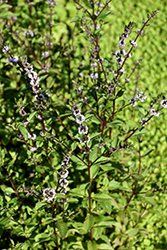It's all about ...
plants

Height: 24 inches
Spread: 3 feet
Sunlight:
![]()
![]()
Hardiness Zone: (annual)
Other Names: Australian Mint
Description:
This mint variety grows fast, quickly colonizing an area and should have some form of root barrier; used in culinary recipes or steeped as a tea; whorls of pretty white flowers rise above bright green foliage on dark burgundy stems in summer
Edible Qualities
River Mint is an annual herb that is typically grown for its edible qualities, although it does have ornamental merits as well. The fragrant oval light green leaves are usually harvested from late spring to early fall. The leaves have a minty taste.
The leaves are most often used in the following ways:
- Fresh Eating
- Cooking
- Seasoning
- Tea
Planting & Growing
River Mint will grow to be about 24 inches tall at maturity, with a spread of 3 feet. Its foliage tends to remain dense right to the ground, not requiring facer plants in front. Although it's not a true annual, this fast-growing plant can be expected to behave as an annual in our climate if left outdoors over the winter, usually needing replacement the following year. As such, gardeners should take into consideration that it will perform differently than it would in its native habitat.
This plant is quite ornamental as well as edible, and is as much at home in a landscape or flower garden as it is in a designated herb garden. It does best in full sun to partial shade. It is quite adaptable, prefering to grow in average to wet conditions, and will even tolerate some standing water. It is not particular as to soil pH, but grows best in clay soils. It is highly tolerant of urban pollution and will even thrive in inner city environments. This species is not originally from North America. It can be propagated by division.
River Mint is a good choice for the edible garden, but it is also well-suited for use in outdoor pots and containers. Because of its spreading habit of growth, it is ideally suited for use as a 'spiller' in the 'spiller-thriller-filler' container combination; plant it near the edges where it can spill gracefully over the pot. It is even sizeable enough that it can be grown alone in a suitable container. Note that when growing plants in outdoor containers and baskets, they may require more frequent waterings than they would in the yard or garden.
